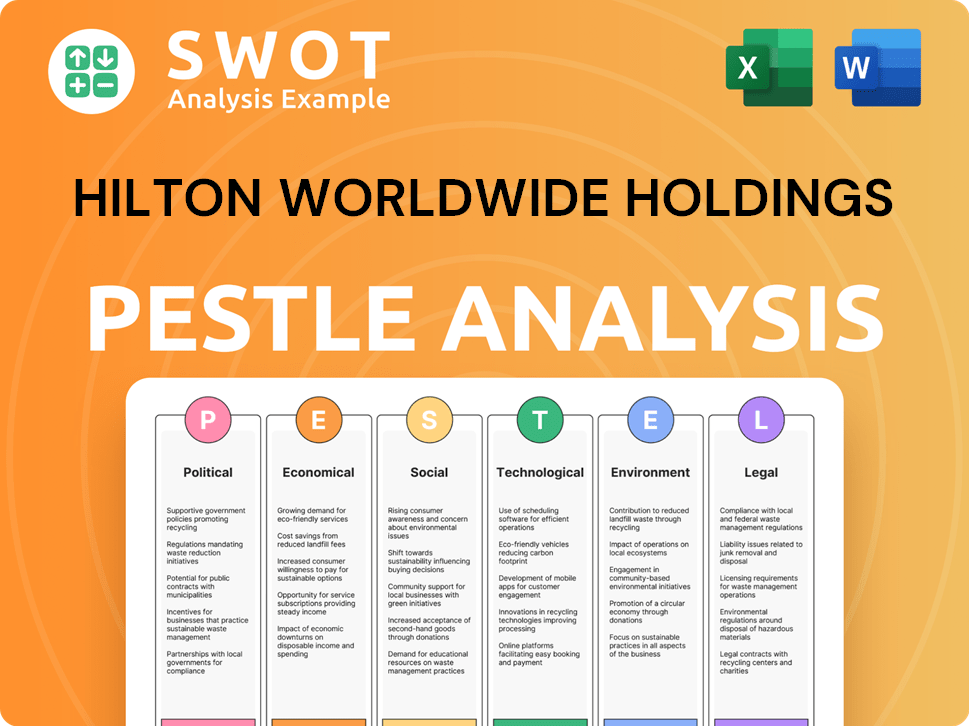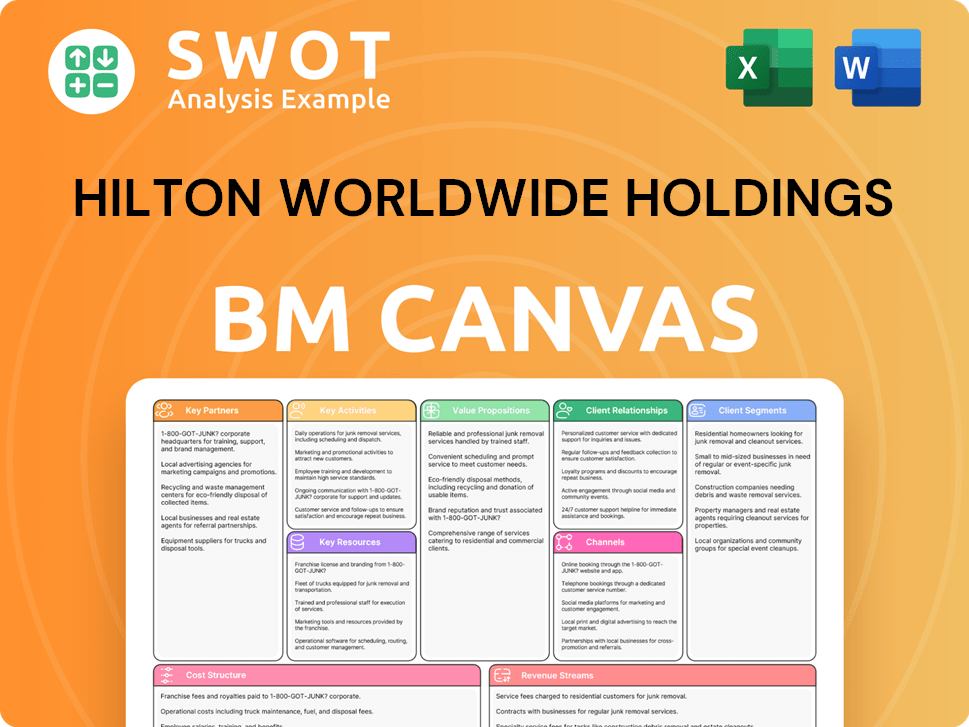Hilton Worldwide Holdings Bundle
How did Hilton Worldwide become a global hospitality giant?
Explore the fascinating Hilton Worldwide Holdings SWOT Analysis and uncover the story of a company that redefined hospitality. From its humble beginnings in Texas to its current status as a global leader, Hilton's journey is a compelling narrative of innovation and strategic expansion. Discover how Conrad Hilton's vision transformed a single hotel into a sprawling empire, shaping the modern hospitality industry.

The Hilton history is a testament to adaptability and foresight. Founded by Conrad Hilton in 1919, the Hotel chain has consistently evolved, embracing technological advancements like HILCRON to enhance guest experiences. Understanding Hilton Worldwide's evolution, from its early years to its current global presence, provides valuable insights into its business strategy and its enduring impact on the hospitality industry.
What is the Hilton Worldwide Holdings Founding Story?
The story of Hilton Worldwide Holdings Inc. begins on May 31, 1919, with Conrad Nicholson Hilton's acquisition of the Mobley Hotel in Cisco, Texas. This marked the start of what would become one of the world's leading hotel chains. Hilton's journey from a small hotel in Texas to a global hospitality giant showcases a remarkable entrepreneurial spirit and strategic vision.
Conrad Hilton, born in 1887, transitioned from a background in his family's general store and a brief stint in politics to focus on the burgeoning hotel industry. His initial investment in the Mobley Hotel, spurred by the Texas oil boom, set the stage for his future endeavors. This pivotal moment highlights Hilton's ability to recognize and capitalize on market opportunities.
Hilton's approach involved acquiring and improving existing properties, focusing on quality service. The first hotel to formally bear the 'Hilton' name opened in Dallas, Texas, in 1925. This strategy, combined with Hilton's understanding of property values and negotiation skills, fueled the company's early expansion. His success was rooted in the post-World War I oil boom in Texas, which created high demand for lodging.
Conrad Hilton's initial venture into the hotel business began with the purchase of the Mobley Hotel in 1919. This marked the beginning of the Hilton history.
- The Mobley Hotel purchase cost US$40,000, equivalent to approximately $725,451 in 2024.
- The first hotel to formally bear the 'Hilton' name opened in Dallas, Texas, in 1925.
- Hilton's strategy focused on acquiring and improving existing properties.
- The early success was driven by the post-World War I oil boom in Texas.
Hilton Worldwide Holdings SWOT Analysis
- Complete SWOT Breakdown
- Fully Customizable
- Editable in Excel & Word
- Professional Formatting
- Investor-Ready Format

What Drove the Early Growth of Hilton Worldwide Holdings?
The early years of Hilton Worldwide, after its establishment, were marked by significant growth and expansion within the hospitality industry. The company's journey began with a focus on the United States, followed by strategic moves into international markets. Key acquisitions and innovations helped shape its trajectory, establishing it as a prominent hotel chain.
After the Dallas Hilton opened in 1925, becoming the first hotel to bear the Hilton name, the company expanded within Texas. Hotels were opened in Waco and El Paso. The Waco Hilton, which opened in 1927, was among the first to feature air conditioning in public areas. By 1934, despite facing financial challenges during the Great Depression, Conrad Hilton owned a network of five hotels in Texas.
Hilton's expansion beyond Texas began in 1938 with the acquisition of the Sir Francis Drake Hotel in San Francisco. By 1943, the company achieved a coast-to-coast presence in the United States with the purchase of the Roosevelt and Plaza Hotels in New York City. This period also saw the formal incorporation of Hilton Hotels Corporation in 1946.
Hilton Hotels Corporation went public in 1947, becoming the first hotel company to be listed on the New York Stock Exchange. International expansion started in 1947 with the management of the Palacio Hilton hotel in Chihuahua, Mexico. The establishment of Hilton International as a wholly-owned subsidiary in 1948 further solidified its global ambitions.
A significant milestone was the acquisition of the Hotels Statler Company in 1954 for $111 million, which expanded Hilton's portfolio significantly. The opening of the Hilton Inn at San Francisco International Airport in 1959 marked Hilton's pioneering of the airport hotel concept. William Barron Hilton took over leadership in 1966, focusing on franchising to drive growth.
Hilton Worldwide Holdings PESTLE Analysis
- Covers All 6 PESTLE Categories
- No Research Needed – Save Hours of Work
- Built by Experts, Trusted by Consultants
- Instant Download, Ready to Use
- 100% Editable, Fully Customizable

What are the key Milestones in Hilton Worldwide Holdings history?
The history of Hilton Worldwide is a testament to its evolution and impact on the hospitality industry. From its early beginnings to its current global presence, Hilton Holdings has consistently adapted and innovated within the dynamic hotel chain landscape.
| Year | Milestone |
|---|---|
| 1947 | Introduction of televisions in hotel rooms at the Roosevelt Hotel, a world first. |
| 1948 | Pioneered the multi-hotel reservation system, a precursor to modern booking platforms. |
| 1954 | Created HILCRON, the world's first central reservations office. |
| 1959 | Launched the first airport hotel and introduced hotel franchising. |
| 1979 | Launched the Hilton Honors loyalty program. |
| 1999 | Acquired the Promus Hotel Group, adding brands like DoubleTree and Embassy Suites. |
| 2007 | Acquired by The Blackstone Group, leading to the formation of Hilton Worldwide. |
| 2013 | Hilton became a public company again with a second IPO. |
Hilton has consistently pushed boundaries through innovation, setting new standards in the hospitality industry. These innovations have not only enhanced guest experiences but also shaped the operational strategies of other hotel chain companies.
Hilton was among the first to introduce televisions in hotel rooms in 1947. The introduction of HILCRON in 1954 revolutionized reservation systems.
In 1948, Hilton launched a multi-hotel reservation system. This system was a significant step forward in guest service and operational efficiency.
Hilton was an early adopter of the hotel franchising model. Franchising allowed for rapid expansion and brand recognition.
Hilton pioneered the concept of airport hotels. This innovation catered to the growing needs of air travelers.
The launch of the Hilton Honors program in 1979 was a key innovation. The program has been instrumental in customer retention and brand loyalty.
The acquisition of the Promus Hotel Group in 1999 was a strategic move. This acquisition significantly broadened Hilton's brand portfolio.
The journey of Hilton has not been without its challenges, including financial difficulties and the need for strategic restructuring. Despite these hurdles, Hilton has demonstrated resilience and adaptability.
Rapid expansion in the early 1960s led to significant debt. This crisis prompted Conrad Hilton to make tough decisions.
The separation of the international Hilton chain in 1964 was a strategic response. This restructuring aimed to stabilize the company.
Hilton has navigated numerous market downturns and faced intense competition. These challenges have tested its resilience.
Hilton has undertaken internal restructuring and rebranding efforts. These changes have been necessary to stay competitive.
The acquisition by The Blackstone Group and subsequent IPOs marked significant shifts. These events reshaped Hilton's financial landscape.
Hilton continuously adapts to changing consumer preferences. This adaptability is key to maintaining market relevance.
For more insights into the business strategies, consider reading Marketing Strategy of Hilton Worldwide Holdings, which provides a deeper dive into how Hilton has navigated its market.
Hilton Worldwide Holdings Business Model Canvas
- Complete 9-Block Business Model Canvas
- Effortlessly Communicate Your Business Strategy
- Investor-Ready BMC Format
- 100% Editable and Customizable
- Clear and Structured Layout

What is the Timeline of Key Events for Hilton Worldwide Holdings?
The Growth Strategy of Hilton Worldwide Holdings has a rich history, starting with Conrad Hilton's first hotel purchase in 1919. Over the years, the company, now known as Hilton Worldwide Holdings, has grown from a single hotel into a global hospitality leader. Key moments include the opening of the first hotel formally named a Hilton in 1925, the formation of Hilton Hotels Corporation in 1946, and the launch of the Hilton Honors loyalty program in 1979. The company has seen significant acquisitions and expansions, including going public again in 2013, and continues to innovate and grow its global footprint.
| Year | Key Event |
|---|---|
| May 1919 | Conrad Hilton purchased his first hotel, the Mobley Hotel, in Cisco, Texas. |
| 1925 | The first hotel formally named a Hilton opened in Dallas, Texas. |
| 1943 | Hilton became the first coast-to-coast hotel chain in the United States with the purchase of hotels in New York City. |
| 1946 | Hilton Hotels Corporation was formed and listed on the New York Stock Exchange. |
| 1947 | The Roosevelt Hotel in New York City became the first hotel in the world to install televisions in guest rooms. |
| 1948 | Hilton introduced the first multi-hotel reservations system. |
| 1949 | Hilton International was established, and the Caribe Hilton Hotel opened in Puerto Rico, marking the company's first international property. |
| 1954 | Hilton acquired the Hotels Statler Company in the world's most expensive real estate transaction at the time and created HILCRON, the first central reservations office. |
| 1959 | Hilton pioneered the airport hotel concept with the opening of the Hilton Inn at San Francisco International Airport. |
| 1964 | Hilton spun off its international operations into a separately traded company, Hilton International Co. |
| 1979 | The Hilton Honors loyalty program was launched. |
| 1999 | Hilton Hotels Corporation acquired Promus Hotel Group, adding brands like DoubleTree and Embassy Suites. |
| 2007 | Hilton Hotels Corporation was acquired by The Blackstone Group, leading to the formation of Hilton Worldwide. |
| 2010 | The Hilton Hotels brand was rebranded to Hilton Hotels & Resorts with a new logo. |
| 2013 | Hilton Worldwide went public again with an initial public offering, raising an estimated $2.35 billion. |
| 2024 | Hilton achieved its largest single-year expansion in history, adding nearly 100,000 rooms and 973 hotels, and surpassed 8,000 hotels open worldwide. |
Hilton continues its global expansion with a focus on new markets. In 2024, the company debuted in Paraguay, Nepal, and Bonaire, extending its presence to 140 countries. The company added nearly 100,000 rooms and 973 hotels in 2024, marking its largest single-year expansion.
The company plans for a net unit growth of 6-7% in 2025. As of February 2024, Hilton had 15,700 new rooms added and 457,300 more in the pipeline. This strategic growth is driven by strong commercial engines and diverse brands.
Hilton is strengthening its luxury portfolio through partnerships. The collaboration with Small Luxury Hotels of the World added hundreds of independent luxury hotels to Hilton's offerings in 2024. This focus aims to enhance guest experiences worldwide.
Key openings planned for 2024 include Signia by Hilton Atlanta, LXR Hotels & Resorts in Waikiki Beach, and Tempo by Hilton in Louisville. These openings highlight Hilton's commitment to innovation and expanding its brand presence.
Hilton Worldwide Holdings Porter's Five Forces Analysis
- Covers All 5 Competitive Forces in Detail
- Structured for Consultants, Students, and Founders
- 100% Editable in Microsoft Word & Excel
- Instant Digital Download – Use Immediately
- Compatible with Mac & PC – Fully Unlocked

Related Blogs
- What is Competitive Landscape of Hilton Worldwide Holdings Company?
- What is Growth Strategy and Future Prospects of Hilton Worldwide Holdings Company?
- How Does Hilton Worldwide Holdings Company Work?
- What is Sales and Marketing Strategy of Hilton Worldwide Holdings Company?
- What is Brief History of Hilton Worldwide Holdings Company?
- Who Owns Hilton Worldwide Holdings Company?
- What is Customer Demographics and Target Market of Hilton Worldwide Holdings Company?
Disclaimer
All information, articles, and product details provided on this website are for general informational and educational purposes only. We do not claim any ownership over, nor do we intend to infringe upon, any trademarks, copyrights, logos, brand names, or other intellectual property mentioned or depicted on this site. Such intellectual property remains the property of its respective owners, and any references here are made solely for identification or informational purposes, without implying any affiliation, endorsement, or partnership.
We make no representations or warranties, express or implied, regarding the accuracy, completeness, or suitability of any content or products presented. Nothing on this website should be construed as legal, tax, investment, financial, medical, or other professional advice. In addition, no part of this site—including articles or product references—constitutes a solicitation, recommendation, endorsement, advertisement, or offer to buy or sell any securities, franchises, or other financial instruments, particularly in jurisdictions where such activity would be unlawful.
All content is of a general nature and may not address the specific circumstances of any individual or entity. It is not a substitute for professional advice or services. Any actions you take based on the information provided here are strictly at your own risk. You accept full responsibility for any decisions or outcomes arising from your use of this website and agree to release us from any liability in connection with your use of, or reliance upon, the content or products found herein.